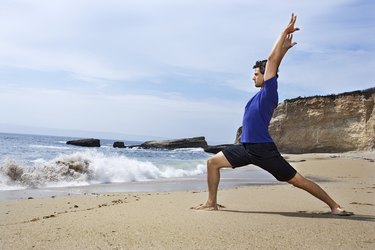
The side lunge is an effective way to work the muscles of your lower body and can be performed using a barbell, dumbbells or as a bodyweight exercise. Side lunges are a useful exercise for sports players as they involve a side-to-side action not normally associated with forward or backward lunges. Side-to-side movements are a big part of non-linear sports like basketball, tennis, baseball and football. Include side lunges in your workout to complement more traditional leg exercises such as squats and regular lunges.
Work That Butt
Video of the Day
Side lunges target your butt, or gluteus maximus muscle, known as your glutes. In addition, the smaller but no less important gluteus minimus and gluteus medius also get in on the act. As it's the glutes on your leading leg that does most the work in this exercise, make sure you do the same number of reps on each leg to work both sides equally.
Video of the Day
Hung Up on Hamstrings
The muscles on the back of your thighs are your hamstrings and work alongside your glutes to control the hip of your leading leg. There are three muscles that make up your hamstrings: biceps femoris, semimembranosus and semitendinosus. Your hamstrings help control your descent into the lunge position and then drive you back up into the start position.
Quaking Quadriceps
Your quadriceps are the muscles on the front of your thigh and are responsible for extending your knee. As you shift your weight onto your lead leg, your quads work to control your descent into the lunge position and then push you upright and back to the starting position. As your set progresses, you'll probably feel your quadriceps working hard and they may even quake and quiver with fatigue.
Adding the Adductors
Lunging sideways places an additional workload on your adductor muscles which are located on the inside of your thighs. Three muscles make up this particular group: adductor longus, adductor brevis and adductor magnus. While the adductors on your lead leg are working with your quadriceps and hamstrings to control your knee and hip movements, the adductors on your trailing leg, which remains straight, get a good stretch.